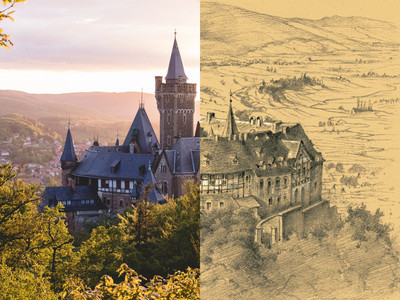The starting point of our hike is the National Park House “Ilsetal” at the large car park in Ilsetal. Here, our National Park Rangers provide tips for your hike and inform you about the National Park.
The path initially follows the Ilse for 5 km along the Heinrich-Heine-Weg. The romantic Ilse Valley is one of the most beautiful valleys in the Harz. Numerous cliffs and rock formations hint at the forces that once shaped the mountains. After about 2 km, you reach the foot of the Ilsestein. This legendary granite rock rises 170 m from the valley floor. The spot from which you look up at the Ilsestein is named in honor of the forest reformer Hans-Dietrich v. Zanthier (1717-1778), who worked as the chief forester of Wernigerode from 1747 to 1778 and laid important foundations for modern forestry.
Our route continues up the Ilse to the Ilse Falls with its many large and small cascades. A memorial stone here commemorates the poet Heinrich Heine, who immortalized the Ilse Valley in 1824 in the “Harzreise”. Attentive hikers will discover many interesting things on both sides of the path: moss- and lichen-covered rocks and deadwood as habitats for mosses, fungi, and animals. It is impressive to see how every death and decay in the natural forest paves the way for new life. Depending on the season, you can observe dipper, nuthatch, peregrine falcon, fire salamander, and brown trout.
From the Bremer Hut, the view wanders to the Brocken, but also over the open areas around the shelter. At first glance, it seems like a small catastrophe – the bark beetle has left dead forest behind. But on closer inspection, you see what follows. Forests planted by humans, consisting exclusively of spruce, are less resilient and therefore vulnerable. But even though the bark beetle has done thorough work here, nature is reclaiming its territory. It allows a new forest to grow among the dead wood.
Opposite the shelter, the path leads left around the Gebbertsberg. The forest landscape has changed here; the mixed deciduous forest in the valley has replaced a former spruce forest. Here, National Park forest development measures will increase the proportion of beech and sycamore maple in their natural range. Shortly before reaching Plessenburg, the proportion of deciduous trees increases noticeably again. The forest restaurant Plessenburg invites you to take a short break.
Freshly refreshed, you reach the Paternoster Cliff (522 m above sea level) on a comfortable path, with a wonderful view of the Ilse Valley and the Brocken. It continues to the Ilsestein (473 m above sea level), one of the landmarks of Ilsenburg. Here stood an imperial castle in the 11th century. Deep within the Ilsestein, legend says the princess’s castle can be found: "And whoever meets Princess Ilse at the right time in the right place will be richly rewarded by her." Even if only with the magnificent view from the Ilsestein over the Ilse Valley up to the Brocken. With luck, you can also hear the distinctive call of the peregrine falcon, which breeds again on the Ilsestein. Here and around the opposite Westerberg Cliff (526 m above sea level), valuable oak-beech-pine forests are protected.
On a forest track, later turning right onto a footpath, you return to Ilsenburg via Blochhauer. Overall, on this hike along well-developed paths, you overcome about 300 meters of elevation gain. From May to October, the "Ilsetaler" (HVB, line 288) runs on Tuesdays, Thursdays, and Saturdays via Ilsenburg through the Ilse Valley to Plessenburg and further to Drei Annen Hohne.







